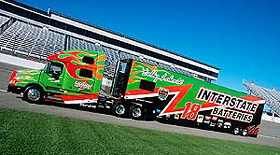How Do Trucking Companies Get Away With It?
Topic 2861 | Page 3

That is good advice. Did you just keep a notebook with a log or something to keep track of it?
That is good advice. Did you just keep a notebook with a log or something to keep track of it?
Yap. I would just write down the load number, the starting and ending location, and the paid miles - both deadhead and loaded. I would also write down any additional pay I may have coming like extra stop pay, detention time, reimbursements, and things of that nature. Then when I got paid I'd make sure everything was there.
Deadhead:
To drive with an empty trailer. After delivering your load you will deadhead to a shipper to pick up your next load.

That is good advice. Did you just keep a notebook with a log or something to keep track of it?
Yap. I would just write down the load number, the starting and ending location, and the paid miles - both deadhead and loaded. I would also write down any additional pay I may have coming like extra stop pay, detention time, reimbursements, and things of that nature. Then when I got paid I'd make sure everything was there.
Guess I am going to have to fire up the old Excel and make a chart for myself? Wonder if anybody has already done an excel template? I am sure somebody has somewhere in this great big little world.
Deadhead:
To drive with an empty trailer. After delivering your load you will deadhead to a shipper to pick up your next load.

I am sure excel would be great since once you get the math formulas in the work sheet it's a simple matter of just putting in the numbers and let the excel worksheet figure it for you......OR you can take 10 seconds write down the 3 to 4 numbers you need and do basic math afterwards on pen and paper since it will not be practical to drag the computer out and fire it up each time for the few seconds it takes to do the math. Not to mention some companies use a sliding pay scale for shorter trips to help get the drivers pay per mile up and that would require re doing the excel worksheet formulas every single time. To big of a pain in the butt.
It's would look something like this....the numbers are examples. Pickup and delivery towns are random cause I did not want to figure out mileage between the two.
Trip # 12345xyz
Deahhead: Memphis TN
Pickup: Little Rock Ar
Delivery: Amarillo TX
Loaded miles: 1000@.30cpm
Deadhead miles: 100
Tarp pay(flatbed): $25
Unload pay: $50
Total pay expected for single trip:
total made for the trip:
Now depending on the size of notebook you can get 10 to 15 trips on one sheet.
Deadhead:
To drive with an empty trailer. After delivering your load you will deadhead to a shipper to pick up your next load.
CPM:
Cents Per Mile
Drivers are often paid by the mile and it's given in cents per mile, or cpm.

My company uses a Rand-McNally program for our dispatching, zipcode to zipcode. However our offices and the two main pipe yards we load at are you located about eight miles NW of the nearest town. To alleviate any discrepancies, we had Rand-McNally come out and rewrite the program showing our actual GPS location. That helps the brokers quote loads for the customers better, dispatch can give us drivers more precise load information and we can trip plan better. And our settlements end up matching our odometers better. A big plus as we're paid by the dispatched mileage, not odometer or hubmeter.
Detention pay is your friend!!! I believe industry standard (unwritten rule) is two hours. I know some companies have shortened that , trying to hold shippers and receivers accountable for delays. We get $15/hr after two hours past our scheduled appointment at drilling rigs and $20/hr on string jobs. It's an incentive for the customers to get you unloaded and on the road in a timely manner.
Shipper:
The customer who is shipping the freight. This is where the driver will pick up a load and then deliver it to the receiver or consignee.
OWI:
Operating While Intoxicated

I just had my wife do a quick excel spreadsheet. She is good at that stuff. I was not really trying to calculate the actual pay on each load with it. It has date, load number, starting location, ending location, starting deadhead mileage, ending deadhead mileage, total deadhead, starting loaded mileage, ending loaded mileage,and total miles. It will total the all the totals for you. She was able to create the spreadsheet for the entire year in 15 minutes. I think then is away to make it enter the date automatically as well.
Deadhead:
To drive with an empty trailer. After delivering your load you will deadhead to a shipper to pick up your next load.

I just had my wife do a quick excel spreadsheet. She is good at that stuff. I was not really trying to calculate the actual pay on each load with it. It has date, load number, starting location, ending location, starting deadhead mileage, ending deadhead mileage, total deadhead, starting loaded mileage, ending loaded mileage,and total miles. It will total the all the totals for you. She was able to create the spreadsheet for the entire year in 15 minutes. I think then is away to make it enter the date automatically as well.
Now you have to figure in the sliding scale mileage pay for the short runs that a lot of companies use. That is setup through contract with the customer.
I know my I pad has an excel program on it which would be easy to get up and running but to have to pull out a laptop every time to input the numbers that might not even be exact will be a pain. Rather do it as I am now cause only takes about 30 seconds to do it which is a lot shorter than a computers boot up time.
Deadhead:
To drive with an empty trailer. After delivering your load you will deadhead to a shipper to pick up your next load.
New Reply:
New! Check out our help videos for a better understanding of our forum features

















Preview:
This topic has the following tags:
Truck Driver Salary Truck Driving Stories







 TT On Facebook
TT On Facebook
For those wondering how trucking companies negotiate freight rates, it's kind of strange. I was told by the operations manager at US Xpress years ago that when they adjust their freight rates they normally don't adjust the pay per mile, they adjust the actual mileage.
For instance, if a trucking company said they would haul a 1000 mile load at $1.50 per mile and the customer wanted a better rate the trucking company might respond by saying, "Ok, we'll cut it to 960 miles". But they wouldn't change the rate per mile. To be honest, I can't remember what he said as to why they do it that way. He told me of course, but that was years ago.
The reason I mention this is because most trucking companies will negotiate this way at times and there's a very good chance that whatever the negotiated mileage turned out to be is what they're going to pay the driver. So the actual miles might be 1000, the HHG miles might be 964, but the negotiated mileage might be 922 and therefor the driver is likely going to get paid 922 miles for that load.
Over the years I always compared the actual trip miles to the paid trip miles and if there was a discrepancy of more than 10% I would request a review of it. There were several times my mileage pay was increased for the load because the paid miles and actual miles were too far apart. So I recommend that everyone check to make sure your paid miles are within reason of the actual mileage. Most of the time they will be but sometimes they won't. If not, mention it to dispatch and see if you can get them to boost the paid miles on that run a bit.
Oh, and one last thing. Always, always, always verify that you were paid correctly for every run. You will find that once in a while the company will either leave a run off your paycheck or short you on the miles. Keep a list of load numbers and paid miles for each run and verify everything in your paychecks.
HOS:
Hours Of Service
HOS refers to the logbook hours of service regulations.OOS:
When a violation by either a driver or company is confirmed, an out-of-service order removes either the driver or the vehicle from the roadway until the violation is corrected.